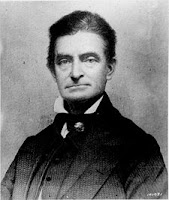 When John Brown led his now-legendary raid on the federal arsenal at Harpers Ferry, Virginia, in 1859, hoping to secure weapons for a slave insurrection, he failed in his immediate goal but succeeded in raising tensions to a fever pitch between pro-slavery and anti-slavery forces. The conflict he had intensified, and which he had now come to symbolize, would lead by 1861 to secession and civil war.
When John Brown led his now-legendary raid on the federal arsenal at Harpers Ferry, Virginia, in 1859, hoping to secure weapons for a slave insurrection, he failed in his immediate goal but succeeded in raising tensions to a fever pitch between pro-slavery and anti-slavery forces. The conflict he had intensified, and which he had now come to symbolize, would lead by 1861 to secession and civil war.
One hundred and fifty years after John Brown’s raid, the New-York Historical Society in partnership with the Gilder Lehrman Institute of American History presents the exhibition John Brown: The Abolitionist and His Legacy, exploring the beliefs, activities and continuing significance of this critical figure, vilified by some as a murderer and venerated by others as a martyr.
On view from through March 25, 2010, this exhibition of rare materials from the Gilder Lehrman Collection and the New-York Historical Society also sets the stage for the culminating presentation of the Historical Society’s Lincoln Year, with the landmark exhibition Lincoln and New York, opening October 9, 2009.
“John Brown’s attack at Harpers Ferry convinced Southerners that their political and economic survival was threatened, while outrage over his execution rallied and unified Northern abolitionists,” according to Louise Mirrer, President and CEO of the New-York Historical Society. “As we continue our year-long celebration of Abraham Lincoln, we hope these extraordinary and seldom-seen materials will not only shed light on Brown himself but will help illuminate events that led to Lincoln’s election in 1860.”
“John Brown: The Abolitionist and His Legacy examines Brown in the context of growing national divisions over slavery in the 1850s,” commented James G. Basker, President of the Gilder Lehrman Institute of American History. “Most African Americans and abolitionists saw John Brown as a martyr for a noble and humane cause. Others saw him as a terrorist who attacked legal institutions and was willing to kill to achieve his goals. This exhibition invites people to examine the tension between these divergent views at the critical moment in American history, with repercussions down through the Civil Rights movement of the 20th century.”
John Brown expected that his attack on Harpers Ferry, carried out by both white and black raiders, would inspire enslaved people to escape from plantations across the South. According to his plan, the former slaves would join him in safe havens in the mountains, where he would arm and train them for guerrilla warfare. The loss of slaves and the fear of insurrection would destabilize the South and build political support in the North.
On Sunday, October 16, 1859, Brown led twenty-one men (sixteen of them white and five black) to Harpers Ferry, Virginia, where they captured the armory, arsenal and rifle factory. A local mob quickly surrounded the town, preventing the raiders from escaping, while federal troops led by Robert E. Lee rushed to the scene. On Tuesday, October 18, soldiers successfully stormed the stronghold, seriously wounding Brown. He was tried and convicted of inciting slave insurrection, treason against Virginia, and murder. Before being hanged on December 2, 1859, Brown wrote prophetically: “I, John Brown, am now quite certain that the crimes of this guilty land will never be purged away but with blood.”
Visitors to the exhibition will encounter manuscripts never before exhibited, including dramatic letters by John Brown to his followers- a letter by Frederick Douglass praising Brown but distancing himself from the raid- Brown’s parting words on the eve of his execution- a letter from the mother of a Kansas murder victim, damning Brown on the scaffold- and reminiscences by Brown’s children and other eyewitnesses.
Lending dramatic context to these materials are powerful images, such as the 1859 sculpture “The Slave Auction” by John Rogers- the heroic 1867 painting by Thomas Satterwhite Noble, “John Brown’s Blessing”- photographs of Brown and his family members- photographs of his supporters, the “Secret Six”- and photographs of other key participants. Among the other important objects on view will be a “John Brown Still Lives!” broadside from 1859- a rare printing of the Emancipation Proclamation- a 1926 lynching poster- and other artifacts of the Jim Crow and Civil Rights eras.
The majority of the objects in the exhibition are drawn from the Gilder Lehrman Collection, currently on deposit at the New-York Historical Society.